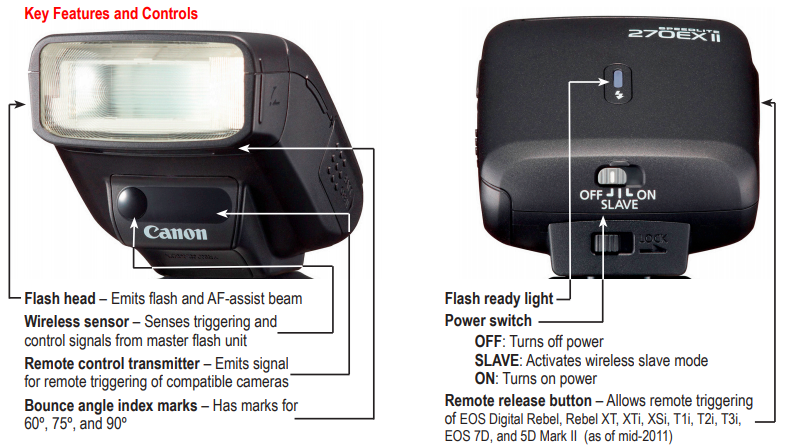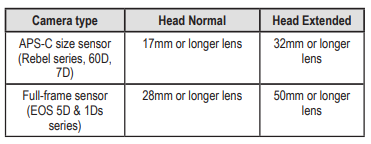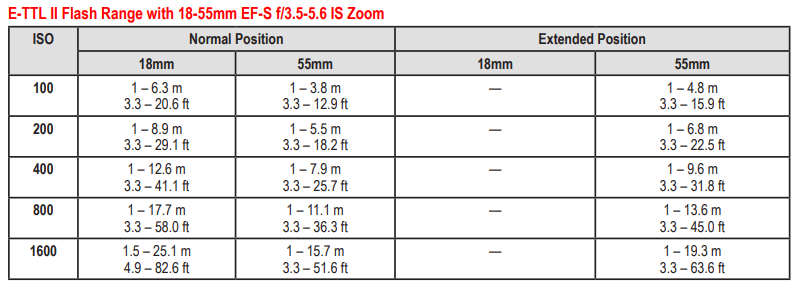The purpose of this QuickGuide is to provide a concise review of how to operate the features and functions of the Canon 270EX II Speedlite. Unless otherwise noted, the following instructions require your Speedlite to be mounted to your camera’s hot shoe. This will allow your camera to communicate with the 270EX II and for you to make flash settings with the camera’s menu system.
Flash Control via the Camera Menus
Any control of the Speedlite 270EX II beyond simple automatic E-TTL exposure requires a camera body with External Flash Control Menu capability, such as the EOS 40D - 60D; Rebel XS/XSi, T1i, T2i, T3, T3i; EOS 7D, 5D Mark II, EOS-1D Mark III / Mark IV, and EOS-1Ds Mark III (as of mid-2011).
E-TTL II Auto Flash Set-up
For cameras with built-in flash:
1. Press the camera Menu button.
2. Select the first Shooting Menu (first camera icon on the left).
3. Select [Flash control] or [External Speedlite control].
4. Select [External flash func. setting]. Press Set.
5. Set [Flash mode] to [E-TTL II] This step is not necessary for cameras that have no built-in flash. It is also not necessary if you have not previously changed the default flash settings on your camera.

Camera Exposure Mode Settings
The 270EX II will function in any of the camera exposure modes below. The maximum speed at which your camera can synchronize with the flash exposure is represented by “1/x sec” (such as 1/200 with EOS Rebel models).

The mode you choose will depend mainly on the balance you prefer between the flash exposure and the ambient light exposure. Longer shutter speeds will allow longer ambient light exposures to help prevent dark backgrounds; however, long exposures also risk blur from subject or camera motion. Smaller apertures provide more depthof-field but require more flash power and reduce the maximum flash range.
Flash Coverage
The flash head can be manually extended or retracted to better match the flash coverage to the camera and lens in use. Refer to the table below for recommended settings.

E-TTL II Flash Range
The flash range will vary depending on the ISO, the angle of coverage, and the maximum aperture of your lens. If you see a blinking

icon in your viewfinder then your subject is too far away. You should either move closer or increase the ISO. Do not use the 270EX II in the extended position with lenses that have a focal length of 30mm or less, otherwise the edges of the frame will be noticeably darker than the center.

Wireless E-TTL Flash Operation
The “Receiver” function allows the flash to be triggered wirelessly when used off-camera with an EOS DSLR or Speedlite with sender flash function. The receiver flash must be positioned off-camera and must be within a range of 33 feet (10 meters) from the sender flash unit.
You can use the 270EX II regardless of the transmission channel (1 to 4) on the sender unit. The receiver ID is set to group A and cannot be changed to group B or C.
1. Set the camera, ST-E2 transmitter or 580EX II Speedlite as the sender unit.
2. Set the 270EX II as the receiver unit by moving the power switch to <slave>.
3. Attach the 270EX II to the mini-stand provided with the flash case and position the flash. When outdoors you must have the wireless sensor aimed directly toward the sender unit. When indoors the sensor will react to reflections from nearby walls.
4. Release the shutter.
Wireless Shutter Release
The flash release function uses the 270 EX II’s built-in infrared transmitter to remotely fire compatible cameras* with a 2-second delay. You can choose whether to use the 270EX II as a wireless trigger alone or whether to also use it as a wirelessly triggered receiver flash.

1. Set the camera* to its remote control shooting mode.
2. Set the 270EX II power switch to <ON>
3. Point the remote control transmitter on the front of the 270EX II toward the camera, then press the remote release button. The shutter will release two seconds later. The 270EX II will not fire.
To trigger camera* + wireless flash:
1. A wireless E-TTL "sender" flash or ST-E2 transmitter must be mounted and active.
2. Set the 270EX II power switch to <slave>.
3. Set the camera* to Remote/Self-Timer mode.
4. Point the remote control transmitter on the front of the 270EX II toward the front of the camera, then press the remote release button. The camera will fire two seconds later, which allows time to reposition the 270EX II to illuminate the subject. The on-camera sender flash will trigger the 270EX II you’re holding to fire during exposure.
*Currently available only on EOS Digital Rebel, Rebel XT, XTi, XSi, T1i, T2i, T3i, EOS 7D, and 5D Mark II.
Auto Power Off
The 270EX II will automatically shut off after 90 seconds of idle use to save battery power. Press the camera’s shutter button to turn the unit on again. Cancel the auto power off function when using the 270EX II as a wireless receiver by pressing the [✻] button on your camera.
AF-Assist Beam
To facilitate autofocus for dark scenes, the 270EX II may fire repeatedly when you press the camera’s shutter button halfway. Its maximum AF-Assist range is approximately 4 m/13.1 ft., depending on the ISO setting and maximum aperture of your lens.
Modeling Flash
Pressing the camera’s depth-of-field button will fire the flash continuously for 1 sec. This enables you to preview lighting effects on the subject. It is most useful when the flash is positioned off-camera.
Do not fire the modeling flash more than 10 consecutive times. If you fire the modeling flash 10 consecutive times, allow the Speedlite to rest for at least 10 min. to avoid overheating and damaging the flash head.